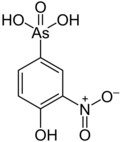4-Hydroxy-3-nitrobenzenearsonic acid
|
|
|||
| Names | |||
|---|---|---|---|
|
IUPAC name
4-Hydroxy-3-nitrobenzenearsonic acid
|
|||
|
Systematic IUPAC name
(4-Hydroxy-3-nitrophenyl)arsonic acid
|
|||
| Other names
3-Nitro-4-hydroxyphenyl arsonic acid
2-Nitrophenol-4-arsonic acid |
|||
| Identifiers | |||
|
3D model (JSmol)
|
|||
| 1976533 | |||
| ChEBI | |||
| ChemSpider | |||
| ECHA InfoCard | 100.004.049 | ||
| EC Number | 204-453-7 | ||
| 1221211 | |||
| KEGG | |||
| MeSH | Roxarsone | ||
|
PubChem CID
|
|||
| RTECS number | CY5250000 | ||
| UNII | |||
| UN number | 3465 | ||
|
|||
|
|||
| Properties | |||
| C 6AsNH 6O 6 |
|||
| Molar mass | 263.0365 g mol−1 | ||
| Melting point | > 300 °C (572 °F; 573 K) | ||
| Hazards | |||
| GHS pictograms |
 
|
||
| GHS signal word | DANGER | ||
| H301, H331, H410 | |||
| P261, P273, P301+310, P311, P501 | |||
|
Except where otherwise noted, data are given for materials in their standard state (at 25 °C [77 °F], 100 kPa).
|
|||
|
|
|||
| Infobox references | |||
Roxarsone is an organoarsenic compound that is widely used in poultry production as a feed additive to increase weight gain and improve feed efficiency, and as a coccidiostat. The drug is also approved in the United States for use in pigs. Roxarsone is marketed as 3-Nitro by Zoetis, a former subsidiary of Pfizer now a publicly traded company. In 2006, approximately one million kilograms of roxarsone were produced in the U.S.
Roxarsone is one of four arsenical animal drugs approved by the U.S. Food and Drug Administration (FDA) for use in poultry and/or swine, along with nitarsone, arsanilic acid, and carbarsone. In September 2013, the FDA announced that Zoetis and Fleming Laboratories would voluntarily withdraw current roxarsone, arsanilic acid, and carbarsone approvals, leaving only nitarsone approvals in place. In 2015 FDA withdraw the approval of using nitarsone in animal feeds. The ban came into effect at the end of 2015. Roxarsone is banned in the European Union.
Roxarsone is a derivative of phenylarsonic acid (C6H5As(O)(OH)2). It was first reported in a 1923 British patent that described the nitration and diazotization of arsanilic acid. When blended with calcite powder, it is used in poultry feed premixes and is usually available in 5%, 20% and 50% concentrations.
...
Wikipedia


